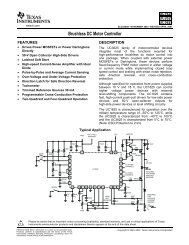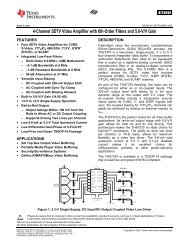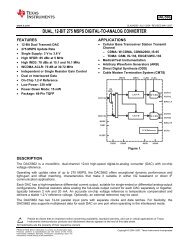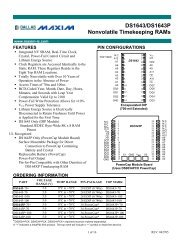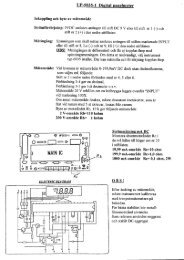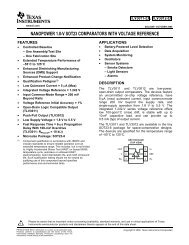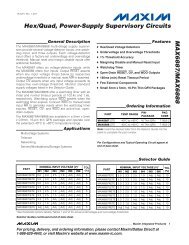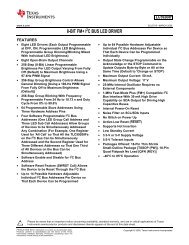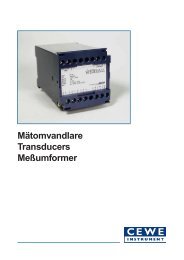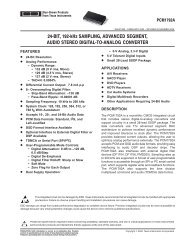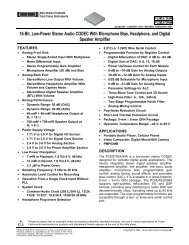Single-Chip Low Power RF Transceiver for Narrowband Systems ...
Single-Chip Low Power RF Transceiver for Narrowband Systems ...
Single-Chip Low Power RF Transceiver for Narrowband Systems ...
Create successful ePaper yourself
Turn your PDF publications into a flip-book with our unique Google optimized e-Paper software.
21. Interrupt on Pin DCLK<br />
21.1. Interrupt upon PLL Lock<br />
In synchronous mode the DCLK pin on<br />
CC1021 can be used to give an interrupt<br />
signal to wake the microcontroller when<br />
the PLL is locked.<br />
PD_MODE[1:0] in the MAIN register<br />
should be set to 01. If DCLK_LOCK in the<br />
INTE<strong>RF</strong>ACE register is set to 1 the DCLK<br />
signal is always logic high if the PLL is not<br />
in lock. When the PLL locks to the desired<br />
frequency the DCLK signal changes to<br />
21.2. Interrupt upon Received Signal<br />
Carrier<br />
Sense<br />
In synchronous mode the DCLK pin on<br />
CC1021 can also be used to give an<br />
interrupt<br />
signal to the microcontroller when<br />
the<br />
RSSI level exceeds a certain threshold<br />
(carrier sense threshold). This function can<br />
be used to wake or interrupt the<br />
microcontroller when a strong signal is<br />
received.<br />
Gating the DCLK signal with the carrier<br />
sense signal makes the interrupt signal.<br />
This function should only be used in<br />
receive mode and is enabled by setting<br />
DCLK_CS<br />
= 1 in the INTE<strong>RF</strong>ACE register.<br />
22. PA_EN and LNA_EN Digital Output Pins<br />
22.1. Interfacing an External LNA or PA<br />
CC1021 has two digital output pins, PA_EN<br />
and LNA_EN, which can be used to<br />
control an external LNA or PA. The<br />
functionality of these pins are controlled<br />
through the INTE<strong>RF</strong>ACE register. The<br />
outputs can also be used as general digital<br />
output control signals.<br />
EXT_PA_POL and EXT_LNA_POL control<br />
the active polarity of the signals.<br />
EXT_PA and EXT_LNA control the<br />
function of the pins. If EXT_PA = 1, then<br />
CC1021<br />
logic 0. When this interrupt has been<br />
detected write PD_MODE[1:0] = 00. This<br />
will enable the DCLK signal.<br />
This function can be used to wait <strong>for</strong> the<br />
PLL to be locked be<strong>for</strong>e the PA is ramped<br />
up in transmit mode. In receive mode, it<br />
can be used to wait until the PLL is locked<br />
be<strong>for</strong>e searching <strong>for</strong> preamble.<br />
The DCLK signal is always logic high<br />
unless carrier sense is indicated. When<br />
carrier sense is indicated the DCLK starts<br />
running. When gating the DCLK signal<br />
with the carrier sense signal at least 2<br />
dummy<br />
bits should be added after the data<br />
payload in TX mode. The reason being<br />
that the carrier sense signal is generated<br />
earlier in the receive chain (i.e. be<strong>for</strong>e the<br />
demodulator), causing it to be updated 2<br />
bits be<strong>for</strong>e the corresponding data is<br />
available on the DIO pin.<br />
In transmit mode DCLK_CS must be set to<br />
0. Refer to CC1021 Errata Note 001.<br />
the PA_EN pin will be activated when the<br />
internal PA is turned on. Otherwise, the<br />
EXT_PA_POL bit controls the PA_EN pin<br />
directly. If EXT_LNA = 1, then the<br />
LNA_EN pin will be activated when the<br />
internal LNA is turned on. Otherwise, the<br />
EXT_LNA_POL bit controls the LNA_EN<br />
pin directly.<br />
These two pins can there<strong>for</strong>e also be used<br />
as two general control signals, section<br />
21.2. In the <strong>Chip</strong>con reference design<br />
SWRS045B Page 60 of 89



